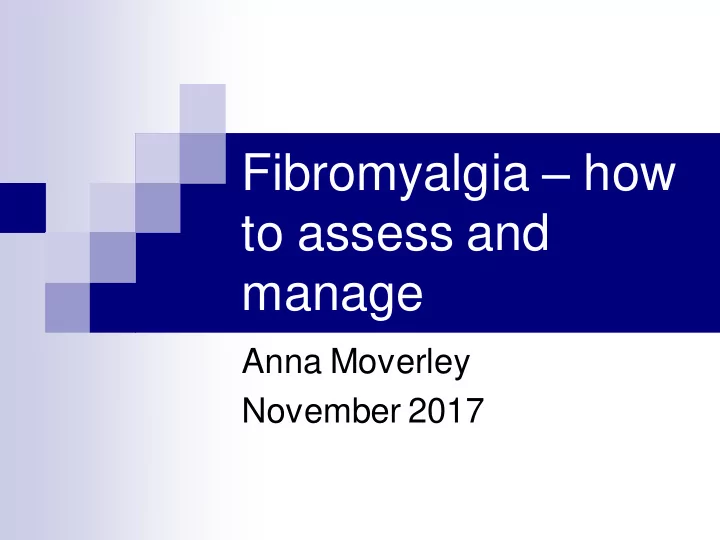

Fibromyalgia – how to assess and manage Anna Moverley November 2017
What we will cover What is fibromyalgia? How do we diagnose it? How do we manage it? What are the indications for referral, what information is needed on the referral and what investigations are needed?
Why is fibromyalgia important? Most common cause of generalized MSK pain in women aged between 20yrs and 55yrs ‘Acquiring a diagnosis of fibromyalgia may lead to increased illness behaviour, dependence on health care providers and increased health care costs’ Kroese 2013, Annals of Rheum
Associated disorders Depression Anxiety Irritable bowel syndrome Bladder irritability Obstructive sleep apnoea Restless legs And many more
What is fibromyalgia and how do we diagnose it?
What is it? Widespread pain to muscles and joints Fatigue Non-restorative sleep Cognitive disturbance
And… Absence of findings on physical examination and laboratory investigations that would explain symptoms
How do we diagnose it?
1990 ACR classification criteria Wolfe et al Arthritis Rheum. 1990;33(2):160 Widespread pain, above and below the diaphragm, left and right sides of body In combination with more than 11/18 tender points as below:
Tender points
Tender points Insertion sub occipital Prominence of greater muscle trochanter Mid trapezium muscle Knee medial fat pad Supra-spinatous tendon Upper outer quadrant origin buttock Under lower SCM muscle Near 2 nd intercostal Control points muscle Thumb Mid forearm 2cm distal from lateral epicondyle Mid forehead
2010 ACR diagnostic criteria (preliminary) All 3 criteria must be met: Widespread pain index (WPI) 7 or above and symptoms severity (SS) (SS) score 5 or above, or WPI 3-6 and SS 9 or above Symptoms at similar level for at least three months Absence of any other diagnosis to explain symptoms
WPI Unilateral Bilateral (one point for each side) Neck Upper arm Upper back Lower arm Lower back Shoulder girdle Chest Greater trochanter Abdomen Jaw Upper leg Lower leg
SS Fatigue graded (0-3) Waking unrefreshed (0-3) Cognitive symptoms (0-3) Where 0 = no symptoms 1 = mild symptoms 2 = moderate symptoms 3 = severe symptoms
SS Somatic symptoms in general None = 0 Mild = 1 Moderate = 2 Great deal of them = 3 Where somatic symptoms include muscle pain, constipation, Raynaud’s, painful urination, abdominal cramps, dry mouth, sun sensitivity etc
FIQ Original score published in 1991 Cumbersome scoring algorithm including reversal of one question and standardisation of first 13 Revised 2009
The Revised Fibromyalgia Impact Questionnaire Domain 1 directions: For each of the following nine questions, check the one box that best indicates how much your fibromyalgia made it difficult to do each of the following activities over the past 7 days: Brush or comb your hair No difficulty Very difficult Walk continuously for 20 minutes No difficulty Very difficult Prepare a homemade meal No difficulty Very difficult Vacuum, scrub, or sweep floors No difficulty Very difficult Lift and carry a bag full of groceries No difficulty Very difficult Climb one flight of stairs No difficulty Very difficult Change bed sheets No difficulty Very difficult Sit in a chair for 45 minutes No difficulty Very difficult Go shopping for groceries No difficulty Very difficult Domain 2: Fibromyalgia prevented me from accomplishing goals for the week Never Always I was completely overwhelmed by my fibromyalgia symptoms Never Always
The Revised Fibromyalgia Impact Questionnaire Domain 3 directions: For each of the following 10 questions, check the one box that best indicates the intensity of your fibromyalgia symptoms over the past 7 days: Please rate your level of pain No pain Unbearable pain Please rate your level of energy Lots of energy No energy Please rate your level of stiffness No stiffness Severe stiffness Please rate the quality of your sleep Awoke rested Awoke very tired Please rate your level of depression No depression Very depressed Please rate your level of memory problems Good memory Very poor memory Please rate your level of anxiety Not anxious Very anxious Please rate your level of tenderness to touch No tenderness Very tender Please rate your level of balance problems No imbalance Severe imbalance Please rate your level of sensitivity to loud noises, bright lights, odours, and cold No sensitivity Extreme sensitivity
How do we manage fibromyalgia?
Pain relief Anti-depressants especially TCAs Physiotherapy and allied health professional input (?CBT) Encouragement/education
EULAR recommendations Full understanding of fibromyalgia requires comprehensive assessment of Pain Function Psychosocial context
Pharmacological interventions Tramadol is recommended for the management of pain in fibromyalgia (Ib A) Simple analgesics such as paracetamol and other weak opioids can also be considered in the treatment of fibromyalgia Corticosteroids and strong opioids are not recommended (IV D)
Tropisetron, pramipexole and pregabalin reduce pain and are recommended for the treatment of fibromyalgia (Ib A) Tropisetron, a serotonin 5HT3 receptor antagonist, has been discontinued in the UK Pramipexole is indicated for restless legs
Antidepressants: amitriptyline, fluoxetine, duloxetine, milnacipran, moclobemide and pirlindole reduce pain and often improve function, therefore they are recommended for the treatment of fibromyalgia (Ib A)
Amitryptiline as mainstay? Often started at low dose and titrated up, given at evening time If ‘hangover’, try giving it earlier in the evening (6pm) Nortriptyline may also be useful Dosulepin is useful but not evidence based
Non-pharmacological Heated pool treatment with or without exercise is effective in fibromyalgia (IIa B) Individually tailored exercise programmes, including aerobic exercise and strength training can be beneficial to some patients with fibromyalgia (IIb C) Cognitive behavioural therapy may be of benefit to some patients with fibromyalgia (IV D)
Other therapies such as relaxation, rehabilitation, physiotherapy and psychological support may be used depending on the needs of the individual patient (IIb C)
What are the indications for referral , what information is needed, and what investigations are needed?
Recommend
More recommend